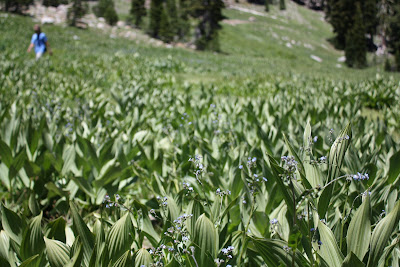The above photo exemplifies the 'ladder' phenomenon, as well as the importance of canopy base height in determining canopy fuels. All the smallest trees are totally burnt, having canopy bases near the ground. Some of the intermediate trees torched because the small trees acted as a ladder for fire, and the intermediates almost acted as a ladder up to this emergent pije. You can see the intermediate tree to its right has torched on one side, very close to the canopy of the emergent pije. Other trees with higher canopies survived, however a few taller (intermediate) trees were torched, likely due to the ladder effect. The conditions pictured are ideal, creating a large amount of diversity in forest structure, because the area has never been subject to fire suppression or logging. This is a fire adapted forest (above). Below is an example of a tsme (mountain hemlock) forest stand. The trees are very far apart with little surface fuels and no ground fuels. This stand generates fuels much more slowly due to species type and elevation, located above 8000' on Brokeoff Mountain.
To the left, in contrast with the above forest stands, is a dense pico stand on the edge of Juniper Lake. This stand appears even-aged and is very dense with low canopy base height. The amount of fuels and the lack of diversity in tree height/canopy height raises the fire regime for this type of stand. Pico does not generate quite as much fuel as abco, which perhaps creates the most surface and canopy fuels of any species in the park.
In the field, I noticed a large amount of variation in species and structure of forest stands, often seeming dependent on elevation. Terrain characteristics, like elevation and aspect, influence the vegetation in the region. It is important to understand that while we can define a fire regime based on: terrain, fuels, and weather; these three characteristics are in no way static or independent. All three variables influence each other and are constantly undergoing change, such as how elevation can influence weather/climate, restricting which species can survive in the area, influencing the amounts/rates of fuels.
The measurements we took in the field gauge canopy fuels very well, as well as a plethora of other data. The number of statistical tests and models that can be generated with this data is immense. Spatial analysis, such as Morisita's index, is possible, as well as complex multivariate analysis like cluster analysis and rotation. While the main goal of the project is to quantify canopy fuels in a map layer, many other features and characteristics of the park can be described as well. Relationships between variables can be examined, such as fuels and species related to elevation or aspect.
The repeat photography project we worked on will be used for a different purpose. Rather than quantifying fire regimes or examining spatial patterns, this project seeks to show dynamic change in a forest structure. This change can then be examined and possible causes hypothesized. In regions where we know the causes of change, the photos are a fantastic teaching tool. These photos may even show evidence of a dynamic of change not yet discovered; a starting point for further research.
We also took several tree cores from subjectively chosen plots. The plots were even-aged fir stands with evidence of previous fire history. The project aims to age all the trees in the plot, and associate them with a previous fire of known date. This can, in turn, help us understand post-fire dynamics, such as shrub-field to tree succession.
Here is a poster I made of some photos and their relative locations. Red lines depict a feature in the picture on the map. White lines depict the location the picture was taken


